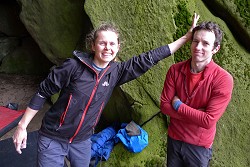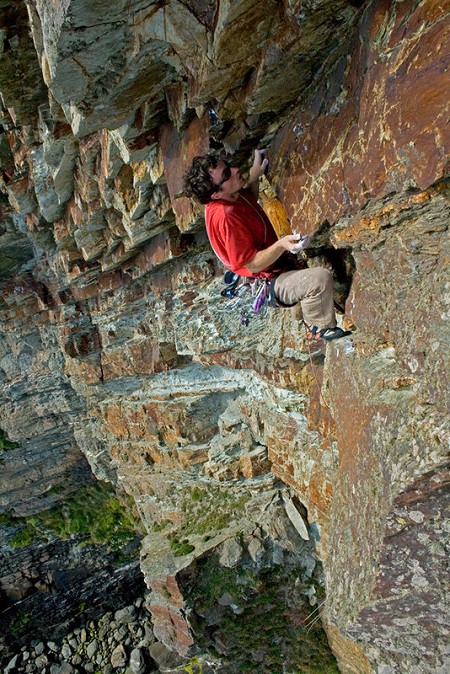

He has onsighted more routes of E7 and E8 than almost every other climber in Britain put together. He also does a bit of sport climbing too, knocking out routes of up to F9a.
For most of the year he works for [ brand ("Plas y Brenin") ] in Wales as a Mountaineering Instructor and you can read a little bit more about James on his website: JamesMcHaffie.com
In this article he gives us some hints and tips on how to improve our climbing.
The desire to be 'better' at something seems to be innate for most people, if it's not a sport that grabs them, it may be something else; writing, photography, chess etc. But regardless of what it is they want to improve at, it's having a strong interest in improving that is often the key factor to success.
If you want to achieve something you can usually immediately go about doing things to help bring it about, if you really are bothered. Over the last decade I've watched lots of climbers succeed at things I thought they had no chance of doing, from a climber going from shaky on E5s to onsighting multiple E7/8s, to a climber who had been climbing V9/10 for a decade knock out a V14 in a 1/2 year period (as well as knocking out most double figure boulder problems in North Wales and going from F8a+/8b on sport to F8c+/9a).

The numbers on paper may not sound much but any experienced and knowledgeable cross disciplined climber will know that to ratchet one grade in performance can feel like trying to lift a car; try all you can it's a bloody struggle, let alone 3 or 4 grades. I love to be shocked in climbing and see people achieve things that didn't seem likely and it's certainly changed my view to a more positive outlook. If you don't believe something is possible it's unlikely you'll do anything towards trying to achieve it - it would seem a waste of time (many people see climbing as just that). This is a death sentence for major climbing improvements, and as Dave MacLeod says, failure should be relished and the greatest gains in climbing are to be gained in areas you are weak in, where failure is likely.
A key mistake is to think that doing anything well is for the 'talented' or 'gifted' individual who is genetically predisposed to doing that activity well. It's been shown in many areas of research that the 'experts' in an activity have just had much longer doing purposeful practice and that the actual gains made when learning an activity or skill are the same as most other people. That being said many people can struggle to find any extra time in already busy lives, but if the desire is strong enough they will.
Most people can make a couple of quick changes to their climbing diet to make quick improvements, or think about areas of climbing they're not that good at and make an effort to do them. If you're terrified of falling on bolts it's an easy issue to deal with, crap at bouldering; make an effort once or twice a week for 30mins to an hour, weak fingers; get a fingerboard.
Start creating good habits to improve the weak areas, the power of accumulation of these habits will normally do the rest.
A goal list can certainly seem geeky but can help compel you to stay keen on the habits you've started to develop. I generally make a list each winter of around 30 climbs including boulder problems, trad routes and sport climbs, some will be well within my usual limit, some near it and some quite beyond my usual limit. I make the 'list' on the premise that if it was the last year you could climb (for whatever reason) which ones would you most regret not trying. Ring friends and plan weekends and trips away to help keep motivation up.


Warm up:
Do at least two steady routes to warm up. Ones you know you should have little chance of failing on. Don't be put off if you feel crap, I've had some of my best days out after struggling to warm up on things that normally feel easy. Make it part of a routine and it pays dividends through climbing better and reducing risk of getting injured.
Clipping the rope into quickdraws:
On lower grade climbs people are often used to using both hands to clip the rope, or they have a favoured hand with which to do it. VDiffs and Severes are often easy angled, meaning you can take both hands off the rock, but if you're wanting to progress to VS+, clip with 1 hand all the time or else face 'learning fast' on your first VS. The anxiety levels are highest as you're usually going to fall furthest at this point (you've just pulled up an arm full of rope!) which helps accentuate the 'fumble clip'. Practicing clipping the rope into quickdraws whilst you are stood on the ground with the carabiners facing left and right with either hand normally makes people's leading much more efficient - the quicker the rope is clipped, the quicker you can relax.
Organise Your Rack of Gear:
Knowing where it is on your harness, keeping it as 'uncluttered' as possible and having things you need first such as wires and friends on the front gear loops of your harness to save faff time looking behind you for the hidden gear.
Belayer position / Belayer:
Most common deck-out zones on indoor walls are by the 2nd and 3rd clip. If you're pushing it on a small cliff like grit there are similar concerns, the ground is close so it's worth checking it out thoroughly for where the gear is and good positions to get it in from. Does the belayer need to be close in and to the left or right of the climb to get the most from low down runners and stop them un-zipping as well as making sure your legs don't catch the belay rope and invert you? I'll often direct my belayer (even though they may be highly qualified instructors) as people often have a habit of switching off to everything apart from checking the screwgate and belaying itself. I've seen a few nasty falls when a wire has looked ok for a downward fall but with a belayer too far out it's popped out in a fall. If somebody is a proper dipsy belayer its worth doing two things for the benefit of all: 1. Tell them. 2. Don't climb with them.
Pre-route checks:
Check knot, rack, belayer, clean boots and then relax your breathing just before setting off. A panicking climber doesn't get less pumped.
On-route checks:
There's nothing like a load of mileage behind you for helping you throw in good protection quickly and to feel confident on the rock. A couple of standard procedures I tend to do before any harder looking section is to: stick a minimum of two good bits of gear in if possible, work out the best sequence taking special note of key footholds on the hard bit, warn my belayer, take a few deep breaths and if the fallout zone is clear, climb as fast as possible to the next gear/rest.
Bouldering:
Some people dislike it, but the fact of the matter is that you can try moves at and beyond your limit for the duration of your climbing session. Doing routes doesn't do it, even on hard sport you'd have to have a selfless belayer to pack as much action in as in a good day out bouldering. Doing trad you get the adventure but also a large stint of belay hours. As an addition to whatever people are used to doing bouldering is normally invaluable for making swift gains. You'll get stronger meaning the cruxes of the routes you do will feel easier as you are using a lower percentage of your maximum power on each move.

Rotpunkt:
Redpointing is a dirty word to many people, it was to me once. I saw climbing as a passion not a science. However even the most ardent disbeliever in redpointing will have done it or else have a very short attention threshold. As soon as you pull back onto a problem you've just fallen off or try a route you've failed on before it's basically a redpoint; going at it with more info than your first attempt.
Speaking recently with Andy Teasdale, a Mountain Guide who had been on a training course with Neil Gresham on Kalymnos was eye opening for how people often don't try things once they fall off. He said he was surprised by doing a route that had seemed very hard on first attempt but went down later that day. The specialist sport climber would hardly see this as a redpoint at all as so little time was spent on it. Redpointing (-trying something a bit beyond your onsight level) is a very good way of improving, it will get you desensitised to falling, make you more secure on the level that you onsight and will usually feed out gains in bouldering, trad etc.
Keeping the Psyche:
Rock climbing has many disciplines which are closely interlinked; bouldering, sport climbing and trad climbing. If you're bored of one of them or have hit a plateau, try out one of the others for a change and it may make you go back to your favourite revitalised and with a fresh approach.
James McHaffie, Hazel Findlay and Jack Geldard are running a coaching/instructing/teaching weekend in Wales this coming June.
The cost of the weekend is £200 per person and over the course of the weekend they will be looking at all aspects of climbing, with a focus on Trad Climbing.
If you want to improve your climbing, get expert advice and a detailed evaluation of your strengths and weaknesses, and have a really good weekend, why not join them?
- FULL COURSE DETAILS: Jackgeldard.com

















Comments